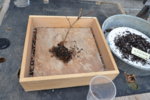Japonicus
Imperial Masterpiece
Good morning Brian!You will find that wiring a trunk and sticking it in the ground isn’t going to be very useful. Several reasons:
1. Wiring slows down growth, so the intended branch will lag behind branches without wire, defeating the purpose.
2. Ground-growing is intended to speed trunk development, so its faster for growing new trunk sections, chopping and healing the resulting scars. This is how you get taper and movement.
3. If you’re not paying very close attention, those wires are going to scar the trunk, which is nearly a forever scar.
4. The trunk girdling is a gamble. You don’t really know what’s going to happen. It’s best to layer in a very controlled, deliberate environment. Cut the cambium, make the layer and keep it at eye-level for a year. When you get good roots, next year you can plant it in the ground with a radial root system, and then let it run.
5. When you do plant a trunk in the ground, resist the temptation to plant the trunks stickinng straight up out of the ground. Plant them at a severe angle. You started to do this here, but the second section appears perpendicular to the ground. The most interesting Bonsai have movement starting right at the base. So many ground-grown trees shoot straight up, then start moving a few inches above the soil. I’m still kicking myself for making this mistake!
Didn’t know wiring slowed. Planned on a 3-4 wk event there but will remove it sooner, today if I lift it again.
The girdling method just felt to have a higher % success rate with no experience in either.
With so much root removal so close to Spring flush, would you recommend extending more damage
and proceeding with a conventional ground layer? Seems there’s different ideas on how to layer.
Whether you recommend furthering this layer immediately or not, would you expose a section or trunk
at planting level, the diameters height, of cambium to be removed, pack that with sphagnum or could you
elaborate a bit more than eye level layer for a year as I have no experience here, which is why I went with
@BackyardBonsai ‘s video suggestion. Wasn’t for laziness but lack of confidence and experience.
On the planting angle in the ground. It was straight up right out of the ground, I couldn’t believe I made that
mistake, then realized I’d kept the girdle level.i dug it back up, and put the angle in the 1st section.
What degree of angle or pointing to what position on the clock should the 2nd portion that’s straight up
perpendicular be at if you were doing this? Maybe leaning forwards as well. Thanks for stopping by Brian.

